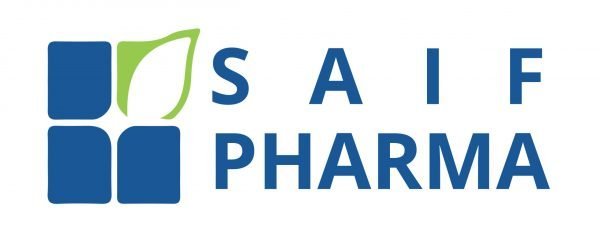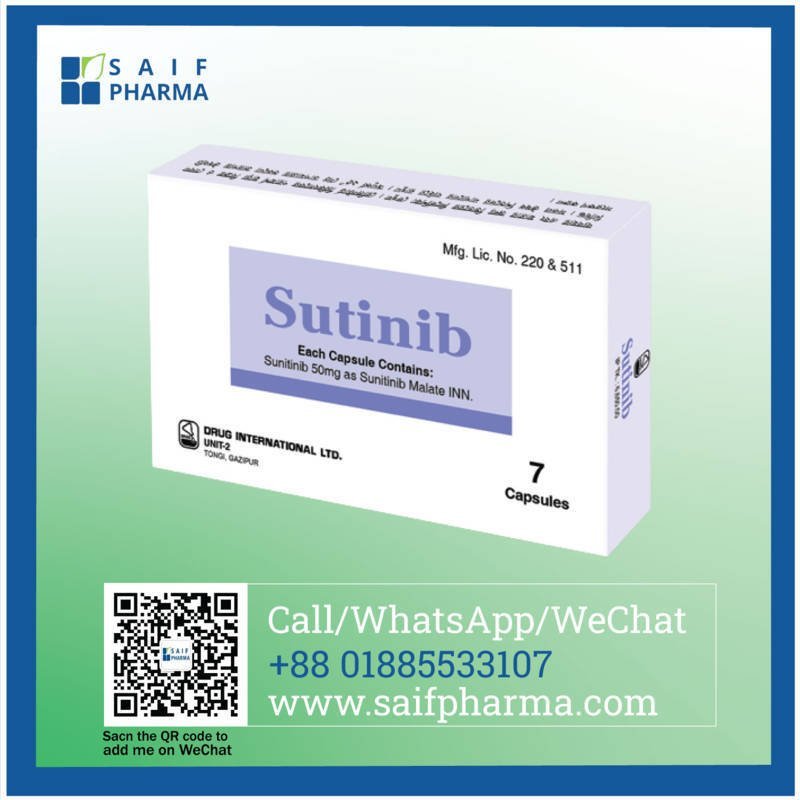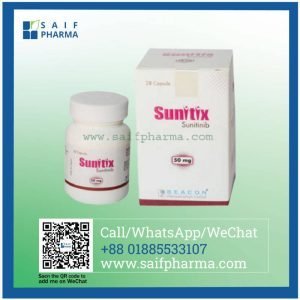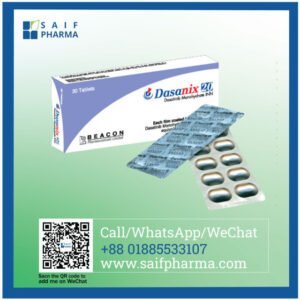Sutinib 50 mg (Sunitinib)
Gastrointestinal Stromal Excrescence( GIST) Sunitinib is indicated for the treatment of gastrointestinal stromal excrescence after complaint progression on or dogmatism to imatinib mesylate.
Advanced Renal Cell Carcinoma( RCC) Sunitinib is indicated for the treatment of advanced renal cell melanoma.
Advanced Pancreatic Neuroendocrine Excrescences( pNET) Sunitinib is indicated for the treatment of progressive, well-discerned pancreatic neuroendocrine excrescences in cases with unresectable locally advanced or metastatic complaints.
Pharmacology
Sunitinib inhibits cellular signaling by targeting multiple receptor tyrosine kinases( RTKs).
These include all receptors for a platelet-deduced growth factor( PDGF- Rs) and vascular endothelial growth factor receptors( VEGFRs), which play a part in both excrescence angiogenesis and excrescence cell proliferation. The contemporaneous inhibition of these targets, thus, reduces excrescence vascularization and triggers cancer cell apoptosis and therefore performing excrescence loss.
Sunitinib also inhibits CD117( c- tackle), the receptor tyrosine kinase that( when inaptly actuated by mutation) drives the maturity of gastrointestinal stromal cell excrescences. It has been recommended as an alternate-line remedy for cases whose excrescences develop mutations in c- tackle that makes them resistant to imatinib, or who can not tolerate the medicine.
In addition, sunitinib binds to other receptors. These include RET, CD114, and CD135. The fact that sunitinib targets numerous different receptors leads to numerous of its side goods similar to the classic hand-bottom pattern, stomatitis, and another dermatologic venom.
Lozenge & Administration
Recommended Cure For GIST And RCC The recommended cure of Sunitinib for gastrointestinal stromal excrescence( GIST) and advanced renal cell melanoma( RCC) is one 50 mg oral cure taken formerly daily, on a schedule of 4 weeks on treatment followed by 2 weeks out( Schedule4/2). Sunitinib may be taken with or without food.
Recommended Cure For pNET The recommended cure of Sunitinib for pancreatic neuroendocrine excrescences( pNET) is37.5 mg taken orally formerly diurnal continuously without a listed out-treatment period. Sunitinib may be taken with or without food.
Cure revision Cure interruption and/ or cure revision in12.5 mg supplements or reductions are recommended grounded on individual safety and tolerability. The maximum cure administered in the Phase 3 pNET study was 50 mg daily.
Strong CYP3A4 impediments similar to ketoconazole may increase sunitinib tube attention. The selection of an alternate attendant drug with no or minimum enzyme inhibition eventuality is recommended. A cure reduction for Sunitinib to a minimum of37.5 mg( GIST and RCC) or 25 mg( pNET) daily should be considered if Sunitinib must be administered with a strong CYP3A4 asset
CYP3A4 corrupters similar to rifampin may drop sunitinib tube attention. The selection of an alternate attendant drug with no or minimum enzyme induction eventuality is recommended. A cure increase for Sunitinib to an outside of87.5 mg( GIST and RCC) or62.5 mg( pNET) daily should be considered if Sunitinib must be administered with a CYP3A4inducer. However, the case should be covered precisely for toxin
If a cure is increased.
Interaction
Increased tube cone with strong CYP3A4 impediments( eg ketoconazole, ritonavir, itraconazole, erythromycin, clarithromycin, grapefruit juice). dropped tube cone with strong CYP3A4 corrupters ( eg rifampin, dexamethasone, phenytoin, carbamazepine, phenobarb, St. John’s wort( Hypericum perforatum)). Anticoagulants eg warfarin, acenocoumarol( periodically cover platelets, prothrombin time/ INR & physical test).
Contraindications
Acuity, Renal impairment
Side goods
Fatigue, GI diseases, skin abrasion, rash, palmar-plantar erythrodysesthesia, dry skin, hair color changes, mucosal inflammation, delicacy, dysgeusia, anorexia, HTN, neutropenia.
Gestation & Lactation
gestation order. There’s positive substantiation of mortal fetal threat grounded on adverse response data from investigational or marketing experience or studies in humans, but implicit benefits may warrant the use of the medicine in pregnant women despite implicit pitfalls.
Overdose goods
Treatment of overdose with Sunitinib should correspond to general probative measures. There’s no specific cure for overdosage with sunitinib. However, the elimination of unabsorbed medicines should be achieved by emesis or gastric lavage, If indicated. Cases of accidental overdose have been reported; these cases were associated with adverse responses harmonious with the given safety profile of Sunitinib, or without adverse responses. A case of purposeful overdose involving the ingestion of mg of Sunitinib in a tried self-murder was reported without adverse response. In clinical studies, mortality was observed following as many as 5 diurnal boluses of 500 mg/ kg( 3000 mg/ m ²) in rats. At this cure, signs of toxin included bloodied muscle collaboration, head shakes, hypoactivity, optical discharge, piloerection, and gastrointestinal torture. Mortality and analogous signs of the toxin were observed at lower boluses when administered for longer durations.







